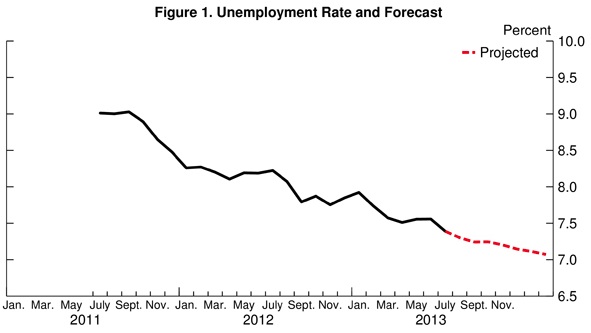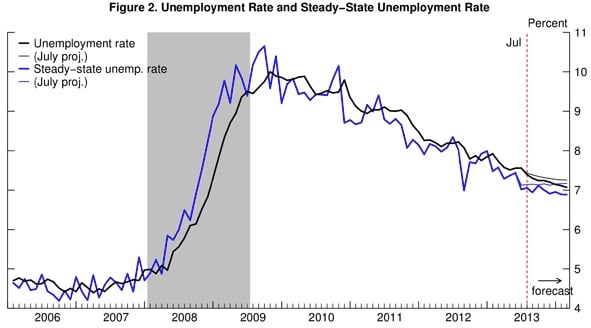After dropping to 7.4% in July, The Brookings Institution predicts unemployment will fall to 7.3% in August.
The Institution says that unemployment will continue to fall at a slow place, being driven principally by “steady-state convergence dynamics,” rather than major improvements in the hiring front.
In an online communiqué, The Brookings Institution wrote “In fact, following disappointing news on the hiring front, the steady-state unemployment rate is currently expected to remain flat at 7% over the next 6 months implying a weaker ‘steady-state convergence dynamics’ going forward and an unemployment rate still above 7% by March 2014.”
The forecast can be more easily understood if you look at the projected behavior of the “steady state” rate of unemployment.
The steady-state unemployment rate currently stands at 7%. According to the Institution’s research, the actual unemployment rate is heading toward this steady state.
If the steady-state unemployment rate is noticeably lower than the actual rate – as is the case at the moment (7% vs. 7.4% respectively) – this “steady-state convergence dynamic” strongly pulls the unemployment rate down, implying a rapid fall in unemployment going forward.
Unemployment rate will probably still be above 7% by March 2014.
However, when we look further ahead, the Institution’s model anticipates the SSUR (steady-state unemployment rate) to remain at about 7% over the next few months. The steady-state convergence dynamic pull will lose its force as the unemployment rate approaches 7%, implying a slowing down in falling unemployment rates for the rest of this year.
The steady-state convergence dynamic will thus become weaker as the unemployment rate converges to 7%.
To more accurately predict the behavior of steady-state unemployment, and consequently the actual unemployment rate, “the model propagates forward its best estimate for how the flows between employment, unemployment and out-of-the labor force will evolve over time.”
The model anticipates little change by the end of this year compared to the essentially flat rate in the number of job vacancies since March 2013, implying a pretty-much constant steady-state unemployment rate.
As the unemployment and steady-state rates converge over the next few months, there will be a slowdown in the falling unemployment rate, “until unemployment settles at around 7%”.



